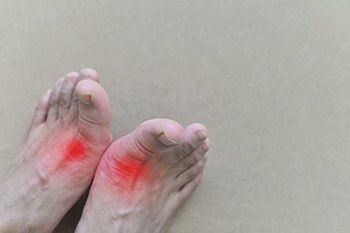
Foot assessment is a fundamental tool in classifying foot types and identifying potential problems. By analyzing the position of the foot at rest and during dynamic movement, podiatrists can infer dynamic foot function and identify abnormalities. Radiologic evaluations serve as the gold standard for assessing foot structure and alignment, providing detailed insight into bone structure and joint alignment. Podiatrists assess feet and conduct thorough evaluations, interpret radiographic findings, and develop tailored treatment plans. Through a combination of physical examination, gait analysis, and imaging techniques, podiatrists can identify conditions such as flat feet, high arches, bunions, and stress fractures, among others. If you would like to understand how your foot structure may be causing your foot problems, it is suggested that you schedule an appointment with this foot doctor for a consultation.
If you have any concerns about your feet, contact Edward Fryman, DPM, FACFAOM from Seaford Foot Care Center. Our doctor can provide the care you need to keep you pain-free and on your feet.
Biomechanics in Podiatry
Podiatric biomechanics is a particular sector of specialty podiatry with licensed practitioners who are trained to diagnose and treat conditions affecting the foot, ankle and lower leg. Biomechanics deals with the forces that act against the body, causing an interference with the biological structures. It focuses on the movement of the ankle, the foot and the forces that interact with them.
A History of Biomechanics
- Biomechanics dates back to the BC era in Egypt where evidence of professional foot care has been recorded.
- In 1974, biomechanics gained a higher profile from the studies of Merton Root, who claimed that by changing or controlling the forces between the ankle and the foot, corrections or conditions could be implemented to gain strength and coordination in the area.
Modern technological improvements are based on past theories and therapeutic processes that provide a better understanding of podiatric concepts for biomechanics. Computers can provide accurate information about the forces and patterns of the feet and lower legs.
Understanding biomechanics of the feet can help improve and eliminate pain, stopping further stress to the foot.
If you have any questions please feel free to contact our office located in Seaford, NY . We offer the newest diagnostic and treatment technologies for all your foot and ankle needs.

Gout, often depicted in old-time images as a wealthy person or aristocratic figure suffering from swollen and inflamed joints, is a form of arthritis caused by the buildup of uric acid crystals in the joints. These portrayals often included exaggerated features such as red, swollen feet, and grimacing facial expressions, highlighting the intense pain associated with gout attacks. Such imagery reflected the prevailing perception that gout was a disease of excess, commonly associated with indulgence in rich foods and alcohol consumption. The accumulation of uric acid typically affects the big toe but can occur in other joints as well. Gout flares are intensely painful, often described as sudden and excruciating. While genetics can predispose individuals to gout, lifestyle factors like diet, alcohol consumption, and obesity also play a role. Treatment for gout focuses on managing pain and reducing uric acid levels through medications, lifestyle changes, and dietary modifications. Contemporary understanding of gout has evolved and a podiatrist can help in its management by diagnosing the condition, providing pain relief strategies, recommending appropriate footwear, and offering guidance on preventing future flare-ups. If you have gout, it is suggested that you partner with a podiatrist to effectively manage your symptoms for better life quality.
Gout is a foot condition that requires certain treatment and care. If you are seeking treatment, contact Edward Fryman, DPM, FACFAOM from Seaford Foot Care Center. Our doctor will treat your foot and ankle needs.
What Is Gout?
Gout is a type of arthritis caused by a buildup of uric acid in the bloodstream. It often develops in the foot, especially the big toe area, although it can manifest in other parts of the body as well. Gout can make walking and standing very painful and is especially common in diabetics and the obese.
People typically get gout because of a poor diet. Genetic predisposition is also a factor. The children of parents who have had gout frequently have a chance of developing it themselves.
Gout can easily be identified by redness and inflammation of the big toe and the surrounding areas of the foot. Other symptoms include extreme fatigue, joint pain, and running high fevers. Sometimes corticosteroid drugs can be prescribed to treat gout, but the best way to combat this disease is to get more exercise and eat a better diet.
If you have any questions please feel free to contact our office located in Seaford, NY . We offer the newest diagnostic and treatment technologies for all your foot and ankle needs.

Athlete's foot is a common fungal infection of the skin, typically occurring between the toes. It thrives in warm, moist environments such as locker rooms, swimming pools, and communal showers. Poor hygiene, sweaty feet, and wearing tight, non-breathable shoes can increase the risk of infection. Prevention primarily revolves around maintaining good foot hygiene practices, including washing and thoroughly drying feet daily, especially between the toes. Wearing clean socks made of breathable materials and changing them regularly can also help prevent fungal growth. Additionally, avoiding walking barefoot in public places and wearing protective footwear in communal areas can reduce exposure to the fungus. Podiatrists play a vital role in treating athlete's foot, offering antifungal medications in various forms, such as creams, powders, or oral medications, depending on the severity of the infection. They may also give guidance on proper foot hygiene and preventive measures to minimize the risk of recurrence. If you have developed athlete’s foot, it is suggested that you visit a podiatrist who can offer you the appropriate treatment method.
Athlete’s Foot
Athlete’s foot is often an uncomfortable condition to experience. Thankfully, podiatrists specialize in treating athlete’s foot and offer the best treatment options. If you have any questions about athlete’s foot, consult with Edward Fryman, DPM, FACFAOM from Seaford Foot Care Center. Our doctor will assess your condition and provide you with quality treatment.
What Is Athlete’s Foot?
Tinea pedis, more commonly known as athlete’s foot, is a non-serious and common fungal infection of the foot. Athlete’s foot is contagious and can be contracted by touching someone who has it or infected surfaces. The most common places contaminated by it are public showers, locker rooms, and swimming pools. Once contracted, it grows on feet that are left inside moist, dark, and warm shoes and socks.
Prevention
The most effective ways to prevent athlete’s foot include:
- Thoroughly washing and drying feet
- Avoid going barefoot in locker rooms and public showers
- Using shower shoes in public showers
- Wearing socks that allow the feet to breathe
- Changing socks and shoes frequently if you sweat a lot
Symptoms
Athlete’s foot initially occurs as a rash between the toes. However, if left undiagnosed, it can spread to the sides and bottom of the feet, toenails, and if touched by hand, the hands themselves. Symptoms include:
- Redness
- Burning
- Itching
- Scaly and peeling skin
Diagnosis and Treatment
Diagnosis is quick and easy. Skin samples will be taken and either viewed under a microscope or sent to a lab for testing. Sometimes, a podiatrist can diagnose it based on simply looking at it. Once confirmed, treatment options include oral and topical antifungal medications.
If you have any questions, please feel free to contact our office located in Seaford, NY . We offer the newest diagnostic and treatment technologies for all your foot care needs.

Freiberg's disease is characterized by cartilage degeneration in the lesser metatarsal heads of the feet, notably affecting adolescent females, though it can occur in both genders later in life. The condition primarily involves the second and third metatarsals. While the exact cause remains unclear, vascular problems, genetic predisposition, and altered biomechanics are common causes. Diagnosis by a podiatrist includes clinical evaluation and imaging confirmation. In many cases X-rays show normal bone formation in early stages and flattened, fragmented metatarsal heads as the disease progresses. Treatment focuses on relieving foot pressure and may involve nonoperative measures such as activity modification and custom orthotic support. Surgical interventions are considered for advanced cases. Outcomes for Freiberg’s disease from both nonoperative and operative management are generally favorable, allowing most patients to resume previous activities. To find out what may be causing metatarsal foot pain, it is suggested that you make an appointment with a podiatrist.
Some foot conditions may require additional professional care. If you have any concerns, contact Edward Fryman, DPM, FACFAOM of Seaford Foot Care Center. Our doctor can provide the care you need to keep you pain-free and on your feet.
Rare Foot Conditions
The majority of foot conditions are common and can be treated by a podiatrist. Standard diagnostic procedures are generally used to identify specific conditions and treatment can be rendered. A podiatrist also treats rare foot conditions which can be difficult to diagnose and may need extra attention and care.
There are many rare foot conditions that can affect children. Some of these can include:
- Freiberg’s disease
- Kohler’s disease
- Maffucci syndrome
Freiberg’s disease - This can be seen as a deterioration and flattening of a metatarsal bone that exists in the ball of the foot. It typically affects pre-teen and teenage girls, but can affect anyone at any age. Symptoms that can accompany this can be swelling, stiffness, and the patient may limp.
Kohler’s disease - This often targets the bone in the arch of the foot and affects younger boys. It can lead to an interruption of the blood supply which ultimately can lead to bone deterioration. The patient may limp or experience tenderness, swelling, and redness.
Maffucci syndrome - This affects the long bones in a child’s foot leading to the development of abnormal bone lesions. They are benign growths and typically develop in early childhood and the bones may be susceptible to breaking.
A podiatrist can properly diagnose and treat all types of rare foot conditions. If your child is affected by any of these symptoms or conditions, please don’t hesitate to call our office so the correct treatment method can begin.
If you have any questions please feel free to contact our office located in Seaford, NY . We offer the newest diagnostic tools and technology to treat your foot and ankle needs.
